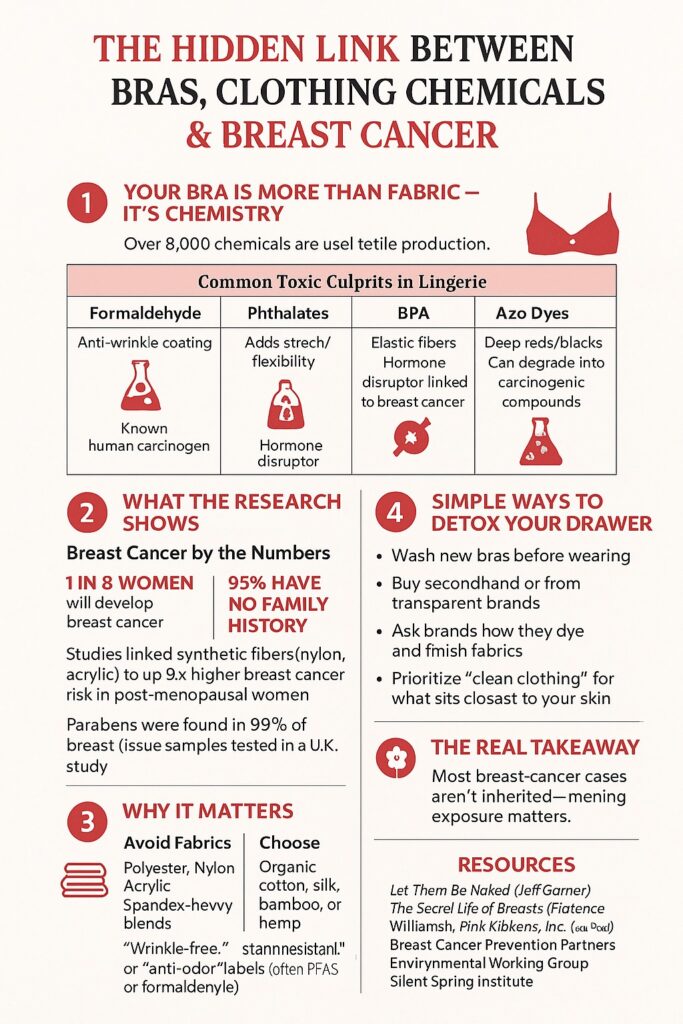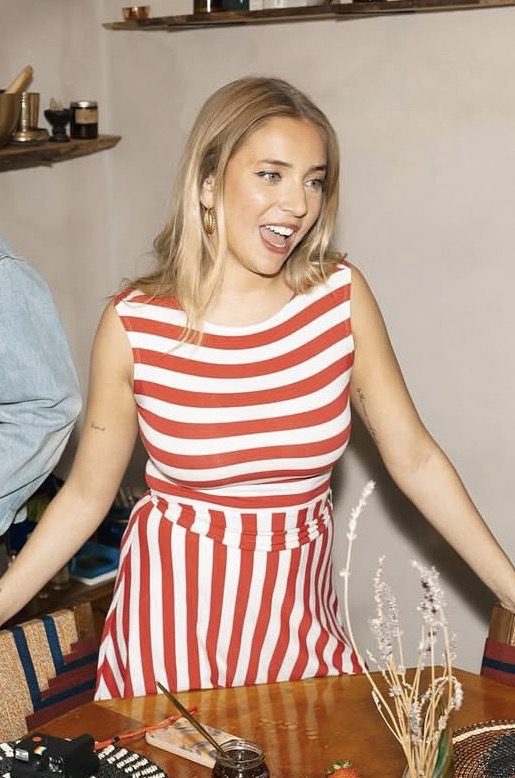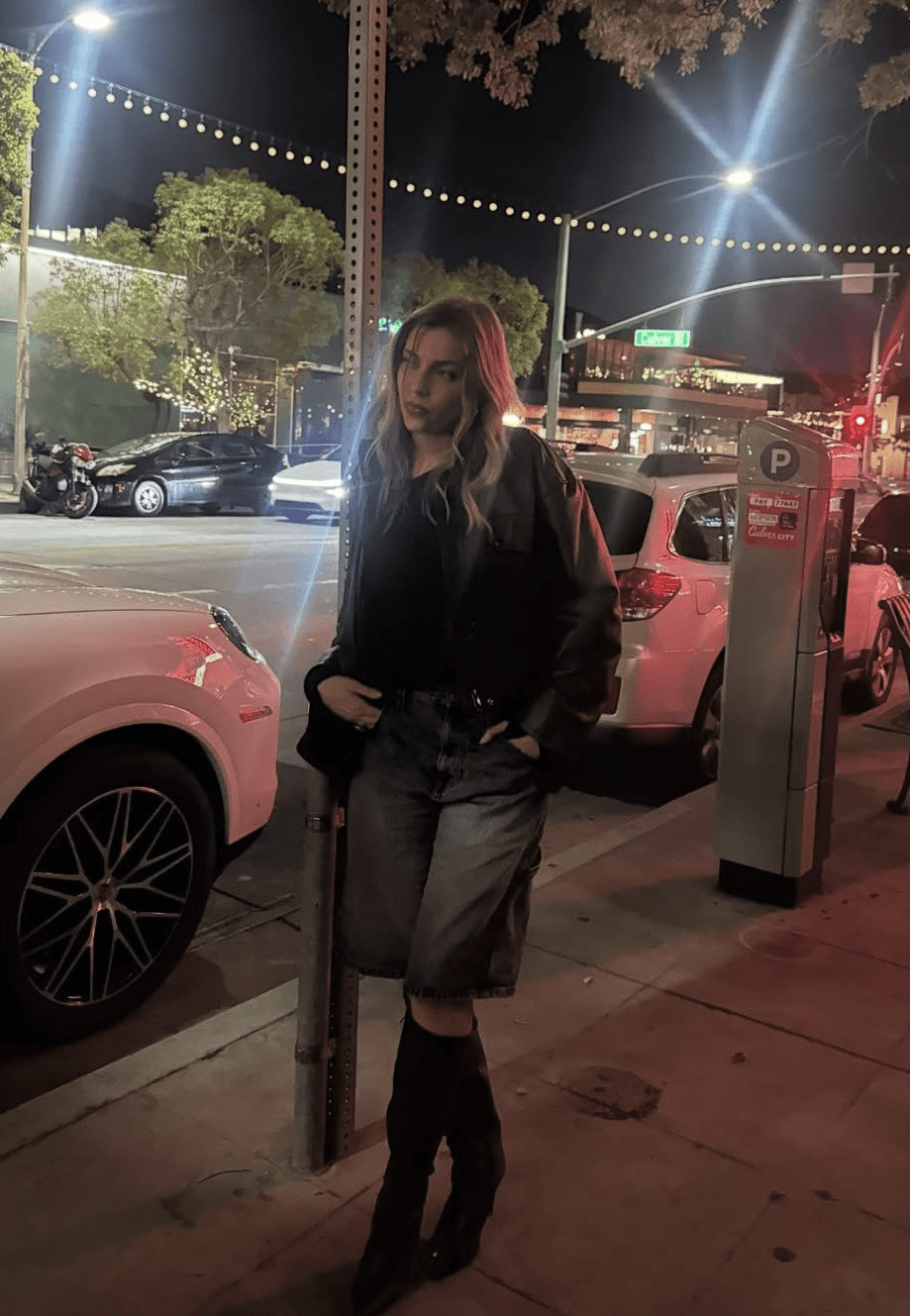We all have that one super comfy bra that’s basically survived the laundry apocalypse or that pretty lace one that makes you feel confident. But here’s a thought that stopped me in my tracks: what if the fabrics hugging our skin every single day are quietly exposing us to toxins linked to breast cancer?
That question hit me hard after watching Let Them Be Naked, a documentary by designer Jeff Garner. He started investigating fashion’s chemical problem after losing his mom to cancer. Around the same time, I discovered The Secret Life of Breasts by Florence Williams, who uncovered how pollutants build up in our bodies, including in breast tissue.
It made me realize something: we talk about clean eating and clean beauty all the time, but what about clean clothing? Especially the pieces that sit closest to our skin.
Because here’s the thing, 1 in 8 women will develop breast cancer, and about 85% have no family history. So while genetics play a role, they’re not the whole story. And when we think about what we wear every day, the story gets a lot more complicated.
Fashion’s Dirty Little Secret
Your clothes aren’t just fabric, they’re chemistry. More than 8,000 synthetic chemicals are reported use in textile manufacturing around the world. We’re talking softeners, dyes, anti-wrinkle coatings, flame retardants… and that’s before we even get to your favorite “buttery-soft” athleisure set.
And lingerie? It’s been reported to be the one of the most chemically treated clothing out there. Many everyday bras and underwear can contain things like:
- Formaldehyde: used to make fabrics “wrinkle-free,” but also a known human carcinogen.
- Phthalates: plasticizers that make materials stretchy, but can mess with your hormones.
- BPA: often found in elastic fibers, another hormone disrupter.
- PFAS (aka “forever chemicals”): used for water- or stain-resistance, but they never break down and build up in the body.
- Azo dyes – those bright reds and blacks? They can degrade into carcinogenic compounds.
Now, I’m not saying your favorite bra is out to get you. But when you think about tight, synthetic fabrics sitting against your skin all day, especially in areas where your pores open up from heat or sweat, it’s fair to ask: what exactly are we absorbing?
What Fashion’s Documentaries Reveal About Clothing Chemicals and Health
In Let Them Be Naked (2024), fashion designer Jeff Garner exposes the toxic truth hiding in our clothes — a mission born from heartbreak. After his mother battled illness that he believes was linked to chemical exposure, Garner began testing everyday fabrics for toxins like benzothiazoles, phthalates, PFAS, and more. His message is simple but gut-punching: no mother should suffer because of invisible poisons woven into what we wear.
Older documentaries sounded the alarm long before Garner’s. Pink Ribbons, Inc. (2011), directed by Léa Pool and produced by the National Film Board of Canada, revealed how major corporations turned breast cancer awareness into a billion-dollar branding opportunity — often selling “for the cause” products laced with the same harmful chemicals that may increase cancer risk. The irony is painful, like promoting clean water while handing out bottles made of BPA-filled plastic.
And The Secret Life of Breasts (2014), based on journalist Florence Williams’ book Breasts: A Natural and Unnatural History, took the science even further. Williams found that most women with breast cancer had no family history — and that pollutants were detectable even in breast milk. Why? Because breasts are mostly fat, and fat stores toxins. Her research made one thing clear: our bodies are quietly collecting the chemical fallout of modern living.
Together, these films shine a light on something we rarely think about: the intersection between what we wear, how it’s made, and the long-term effects on our health.
Clothing Chemicals Linked to Breast Cancer
While scientists are still piecing together all the links, the early findings are worrying.
A Canadian study of post-menopausal women found that those exposed daily to synthetic fibers like nylon and acrylic were significantly more likely to develop breast cancer later in life — with acrylic exposure raising risk up to eight-fold. Another recent case-control study from Montreal reinforced those findings, showing a clear connection between occupational textile exposure and invasive breast cancer risk.
And it’s not just consumers. Textile workers — especially those in dyeing and finishing plants — face some of the highest levels of chemical exposure. Multiple studies have found that workers regularly handling dyes, solvents, and finishing agents experience elevated rates of several cancers, including breast, bladder, and lung.
Then there are parabens, preservatives used not just in beauty products but sometimes in clothing finishes to prevent mold and bacteria. One U.K. study detected parabens in 99% of breast tissue samples tested, suggesting that these estrogen-mimicking chemicals can accumulate in the body over time — even among women who never used underarm products.
And the regulations? Let’s just say they’re lacking. The European Union bans around 1,000–1,500 textile chemicals under its REACH legislation, while the United States restricts fewer than 40. Out of the roughly 80,000 chemicals in circulation here, only about 1,000 have been tested for hormone-disrupting effects.
So no, your bra alone isn’t the villain. But the bigger problem is a fashion system built on chemical secrecy — one that allows thousands of untested, largely unregulated substances to sit right up against our skin every single day.
The good news? Some researchers are working to change that. The Sister Study, led by the National Institute of Environmental Health Sciences, has tracked over 50,000 women to explore environmental links to breast cancer. [NIEHS] The Silent Spring Institute has identified more than 900 chemicals with traits linked to breast cancer risk, helping scientists prioritize which ones to study and regulate next. [Silent Spring Institute, 2024] And a new wave of studies is looking at PFAS, or “forever chemicals,” and how they may make breast cancer cells more aggressive. [UNC Chemistry, 2025]
The evidence may still be building, but the pattern is hard to ignore: the fibers, finishes, and coatings we wear every day are part of a much bigger chemical story — one that’s finally starting to get the scientific attention it deserves.
What You Can Actually Do (No, You Don’t Have to Panic-Buy Hemp Everything)
1. Shop Smarter
- Look for GOTS, OEKO-TEX Standard 100, or Bluesign labels — they mean safer fabrics.
- Choose natural fibers like organic cotton, hemp, silk, bamboo, or linen.
- Be cautious of words like wrinkle-free, stain-resistant, or anti-odor — they’re usually red flags for chemical coatings.
- Prioritize clean clothing where it matters most: bras, underwear, sleepwear, and activewear.
2. Detox Your Closet
- Wash new clothes before wearing. It helps remove leftover residues from manufacturing.
- Love secondhand. The more a garment’s been washed, the fewer chemicals it holds.
- Support transparent brands that disclose dyeing and finishing processes.
3. Think Bigger
- Ask brands tough questions. If they say they care about women’s health, hold them accountable.
- Support stronger chemical-safety laws in fashion.
- Donate to or amplify organizations that research environmental links to breast cancer.

How to Protect Yourself from Toxic Fabrics
This isn’t about fear — it’s about awareness. Most breast-cancer cases aren’t inherited, which means exposure plays a role. And when you think about it, we wrap our most sensitive areas in synthetic fabrics every single day.
Our skin isn’t armor — it’s a sponge. And if we care about what goes into our bodies, it’s time we start caring about what sits on them too.
So next time you’re shopping for a bra or tee, flip the tag, do a little research, and choose with intention. Because the most powerful thing we can wear isn’t lace or Lycra — it’s awareness.

Follow me on my socials:
- Instagram: @lexysilverstein
- Youtube: Lexy Silverstein
- Twitter: @eLEXYfy
- TikTok: @lexysilverstein
- Facebook: Lexy Silverstein
- Liketoknow.it/lexysilverstein
You can email me at LexySilverstein@gmail.com




